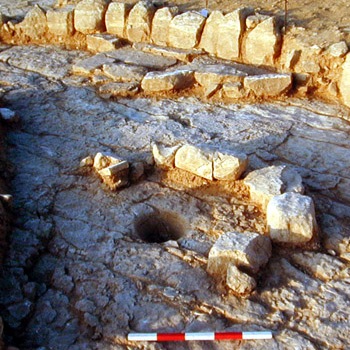
A piece of obsidian.

The position of Melos (oggi).

Natufiano mortar at Upper Besor VI.



Several interesting facts occurred during the glacial/interglacial transition. Seafaring activity spread throughout the Mediterranean and became soon more sophisticated: 17,000 years ago men were already capable of offshore fishing, as documented by the remains found in caves near Mentone (Cleyet-Merle, 1990: 26). But it was 13,000 years ago, at the beginning of the Younger Dryas (after the 1500 years long warm period that followed the MWP-1a), that two events show a qualitative leap in the navigation: the colonization of Cyprus, which implied a sea crossing of 65 km (Ammerman et al., 2006), and the establishment of "regular" sea routes for the transport of obsidian from Melos and Argolis (Renfrew and Aspinall, 1990).
At the same time, on the mainland opposite to Cyprus, in the western tip of the Fertile Crescent, men began to select the grain to grow (Purugganan & Fuller, 2009). In fact, although wild cereals had been already part of the human diet since the Last Glacial Maximum (20,000 years ago) (Kislev et al., 1998), before 13,000 years ago we cannot determine if they were cultivated or spontaneous, because the domesticated species appear in this remarkable period. In the same region, between the two MWP (from 14,500 to 11,500 years ago) appeared also the first Neolithic Natufian villages (Bar-Yosef, 1998), showing the first stone homes and a kind of utensils and ornaments never seen before (Bar-Yosef Mayer & Porat, 2008).
In short, in the Aegean archipelago and the Near East, some revolutionary technologies, marine and terrestrial, appeared in correspondence of the climatic changes that occurred between the two MWP. Maybe it was the ingenuous response to the new climatic conditions, or maybe it was simply the lifestyle of somebody who already had the know how and who moved there. With no doubt, in fact, another thing characterized that tormented period: the abandonment of the land flooded for the sea level rise and the consequent migration of its former occupants.
Since no findings preceding MWP-1a let suspect the existence of “advanced” civilizations prior to 14,500 years ago [1], the hypothesis of adaptation to the climatic change brought by the MWP-1a is credible. In a short time the temperature rose to current levels, precipitation decreased and summers became longer and warmer. Perhaps the usual wild grains did not grow easily anymore and it was necessary to irrigate selected land to breed them (the birth of agriculture). For sure, longer summers and calmer sea extended the season of navigation, allowing improvements in seafaring techniques. In fact, the MWP-1a climate change had several characteristics that could justify the transformations that occurred.
Summing up: 13,000 years ago, in the Aegean Sea navigation was developed and perfected (principally to get obsidian, then a valuable good) and in the Middle East cereals were domesticated to be cultivated. Either these new habits emerged spontaneously to adapt to new climatic conditions or where brought there by a newly settled population that already shared them, there is an obvious consequence: in conditions geographically and climatically similar, people subject to the same stress could have developed similar innovations. Are there other Mediterranean regions sharing this similarity? Yes: the islands in the Strait of Sicily.
[1] The human tendency to live near the sea had an obvious consequence on the distribution of archaeological sites: it is likely that most of the areas inhabited during the ice age are on shallow marine banks, which were then emerged shores (Bailey & Flemming, 2008). In fact, most of the remains preceding MWP-1a should actually be on the bottom of the sea, since today’s banks were the likeliest Palaeolithic habitats. This could explain the lack of findings, but this is a condition that applies also to the MWP-1b: also the remains of the Younger Dryas occupations should lay mostly on shallow marine banks. On the other hand, as we have seen, the traces the evolution of "Yungerdryasans" have been found.
Ammerman, A.J., P. Flourentzos, C. McCartney, J. Noller and D. Sorabji (2006) Two new early sites on Cyprus. Report of the Department of Antiquities, Cyprus: 1-21..
Bailey, Geoffrey N., Nicholas C. Flemming, (2008) Archaeology of the continental shelf: Marine resources, submerged landscapes and underwater archaeology. Quaternary Science Reviews 27 2153–2165.
Bar-Yosef, Ofer (1998), The Natufian Culture in the Levant, Threshold to the Origins of Agriculture, Evolutionary Anthropology 6 (5): 159–177.
Bar-Yosef Mayer Daniella E. and Naomi Porat (2008), Green stone beads at the dawn of agriculture, 8548–8551 PNAS June 24, 2008, vol. 105 no. 25
Cleyet-Merle, J. J. (1990) La préhistoire de la pêche: 26, Ed. Errance, París..
Kislev, M. E., Nadel, D. & Carmi, I. Epipalaeolithic cereal and fruit diet at Ohalu II, Sea of Galilee, Israel. Rev. Palaeobot. Palyn. 73, 161–166 (1992).
Purugganan M. D. & Fuller D. Q. (2009) The nature of selection during plant domestication. Nature 457, 843-848.
Renfrew, C., and A. Aspinall (1990) Aegean obsidian and Franchthi Cave. In C. Perlès, Excavations at Franchthi Cave, Greece, Fascicle 5: Les industries lithiques taillées de Franchthi (Argolide, Grèce) II. Les industries du Mésolithique et du Néolithique initial, 257-70. Bloomington and Indianapolis: Indiana University Press.
Dal 2012 ci sono stati accessi al sito;
Atlantide è stata visitata volte.